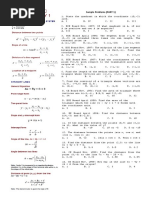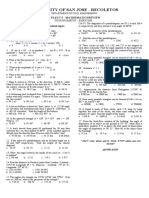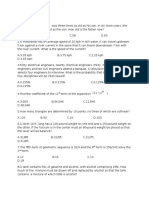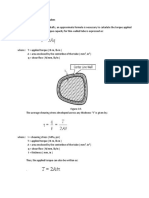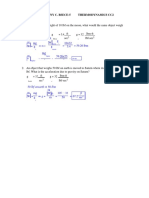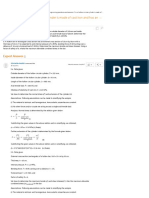Axial Deformation Sample
Axial Deformation Sample
Uploaded by
Bobbles D LittlelionCopyright:
Available Formats
Axial Deformation Sample
Axial Deformation Sample
Uploaded by
Bobbles D LittlelionOriginal Description:
Original Title
Copyright
Available Formats
Share this document
Did you find this document useful?
Is this content inappropriate?
Copyright:
Available Formats
Axial Deformation Sample
Axial Deformation Sample
Uploaded by
Bobbles D LittlelionCopyright:
Available Formats
1.
A steel rod having a cross-sectional area of 300 mm2 and a length of 150 m is
suspended vertically from one end. It supports a tensile load of 20 kN at the
lower end. If the unit mass of steel is 7850 kg/m3 and E = 200 × 103 MN/m2, find
the total elongation of the rod.
Elongation due to its own weight:
δ1=PL/AE
Where:
P = W = 7850(1/1000)3(9.81)[300(150)(1000)]
P = 3465.3825 N
L = 75(1000) = 75 000 mm
A = 300 mm2
E = 200 000 MPa
Thus,
δ1=3465.3825(75000)/300(200000)
δ1=4.33 mm
Elongation due to applied load:
δ2=PL/AE
Where:
P = 20 kN = 20 000 N
L = 150 m = 150 000 mm
A = 300 mm2
E = 200 000 MPa
Thus,
δ2=20000(150000)/300(200000)
δ2=50 mm
Total elongation:
δ=δ1+δ2
δ=4.33+50
δ =54.33 mm answer
Engr. MIMD Villalobos
2. A steel wire 30 ft long, hanging vertically, supports a load of 500 lb. Neglecting
the weight of the wire, determine the required diameter if the stress is not to
exceed 20 ksi and the total elongation is not to exceed 0.20 in. Assume E = 29 ×
106 psi.
Based on maximum allowable stress:
σ=P/A
20000=500/(1/4)πd^2
d=0.1784in
Based on maximum allowable deformation:
δ=PLAE
0.20=500(30×12)/(1/4)πd^2(29×106)
d=0.1988in
Use the bigger diameter, d = 0.1988 inch. answer
Engr. MIMD Villalobos
3. An aluminum bar having a cross-sectional area of 0.5 in2 carries the axial
loads applied at the positions shown in Fig. P-209. Compute the total change in
length of the bar if E = 10 × 106 psi. Assume the bar is suitably braced to prevent
lateral buckling.
Solution.
P1 = 6000 lb tension
P2 = 1000 lb compression
P3 = 4000 lb tension
δ=PL/AE
δ=δ1−δ2+δ3
δ=6000(3×12/)0.5(10×106)−1000(5×12)/0.5(10×106)+4000(4×12)/0.5(10×106)
δ=0.0696 in. (lengthening) answer
4. Solve prob. 3 if the points of application of the 6000-lb and the 4000-lb forces
are interchanged.
P1 = 4000 lb compression
P2 = 11000 lb compression
P3 = 6000 lb compression
δ=P/LAE
δ=−δ1−δ2−δ3
δ=−4000(3×12)/0.5(10×106)−11000(5×12)/0.5(10×106)−6000(4×12)/0.5(10×106)
δ=−0.2184 in=0.2184 in (shortening) answer
Engr. MIMD Villalobos
You might also like
- Cosh Day 1 2Document95 pagesCosh Day 1 2Bobbles D LittlelionNo ratings yet
- Cosh Day 1 2Document95 pagesCosh Day 1 2Bobbles D LittlelionNo ratings yet
- Time Value of MoneyDocument26 pagesTime Value of MoneyBobbles D LittlelionNo ratings yet
- MECC481 - 5 - Physics Statics of Rigid BodiesDocument61 pagesMECC481 - 5 - Physics Statics of Rigid BodiesSydney OlandriaNo ratings yet
- Sample Problems (PART 1)Document7 pagesSample Problems (PART 1)Mark Carlo BautistaNo ratings yet
- Midterm Practice Prob 1Document1 pageMidterm Practice Prob 1Kevin NavidadNo ratings yet
- MEEN 20052 - Week 4 - Salamat, Andre Agassi D.Document4 pagesMEEN 20052 - Week 4 - Salamat, Andre Agassi D.andreagassiNo ratings yet
- Exchap 02 AnsDocument11 pagesExchap 02 AnsMewnEProwtNo ratings yet
- Strength Co1Document103 pagesStrength Co1prince janeoNo ratings yet
- 1.system of Numbers and ConversionDocument20 pages1.system of Numbers and ConversionAmpolNo ratings yet
- Fluid Concepts - AdvanceDocument18 pagesFluid Concepts - AdvanceRenzel BaulaNo ratings yet
- 02 03ChapGereDocument16 pages02 03ChapGereXavier Pacheco PaulinoNo ratings yet
- Fundamentals Rules of Counting and Probability: Number of Favorable Ways Total Number of WaysDocument6 pagesFundamentals Rules of Counting and Probability: Number of Favorable Ways Total Number of WaysJemuel Awid RabagoNo ratings yet
- Strain (Continuation) PDFDocument3 pagesStrain (Continuation) PDFNadlor Gasco OzausNo ratings yet
- SolutionsManual CH 02Document92 pagesSolutionsManual CH 02King AragornNo ratings yet
- Differential CalculusDocument31 pagesDifferential CalculusDhmi yassinNo ratings yet
- Heat TransferDocument39 pagesHeat TransferJoshua James SarabiaNo ratings yet
- CEERSDocument13 pagesCEERSRyan CireraNo ratings yet
- Properties of Fluids: Sample Problems BDocument4 pagesProperties of Fluids: Sample Problems BFronda Jerome BlasNo ratings yet
- Sequence and ProgressionDocument4 pagesSequence and ProgressiondeevoncNo ratings yet
- 5.clock, Variation and Progression PDFDocument17 pages5.clock, Variation and Progression PDFAmpolNo ratings yet
- Chapter 12Document8 pagesChapter 12이희인No ratings yet
- Sinusoidal Source Electrical Ciruits AC NotesDocument5 pagesSinusoidal Source Electrical Ciruits AC NotesTiffany Fate AnoosNo ratings yet
- Superimposed, Reinforced, Built-Up Timber BeamsDocument16 pagesSuperimposed, Reinforced, Built-Up Timber Beamsmnmusor0% (1)
- College Physics EOC Questions Chapter 8Document9 pagesCollege Physics EOC Questions Chapter 8Sri RNo ratings yet
- Exer1322 PDFDocument21 pagesExer1322 PDFNelva CSNo ratings yet
- 3-5 Torsion of Thin Walled TubesDocument3 pages3-5 Torsion of Thin Walled TubesStephanie Danielle HizoleNo ratings yet
- D.E. QuestionsDocument9 pagesD.E. Questionsrobertz_tolentino0140% (1)
- Questions For MathDocument16 pagesQuestions For MathNicholson ZapantaNo ratings yet
- Day 8 Plane Geometry December 01 20212Document51 pagesDay 8 Plane Geometry December 01 20212Free student100% (1)
- Albon, I - Ac 311 PretestDocument4 pagesAlbon, I - Ac 311 PretestjerkNo ratings yet
- Chapter5.4 Unsymmetrical BeamsDocument8 pagesChapter5.4 Unsymmetrical BeamsMaryanne Rempillo MarañaNo ratings yet
- ThermoproblemDocument20 pagesThermoproblemmark anthony tutorNo ratings yet
- Mesl Looksfam - 01Document30 pagesMesl Looksfam - 01Alan Je MusketerNo ratings yet
- Correl ReviewDocument68 pagesCorrel ReviewAlvy CaballeroNo ratings yet
- Question: 5 A. A Hollow Circular Cylinder Is Made of Cast Iron and Has AnDocument2 pagesQuestion: 5 A. A Hollow Circular Cylinder Is Made of Cast Iron and Has AnMustafa KhudhairNo ratings yet
- FluidsDocument1 pageFluidsnico aspraNo ratings yet
- ThermodynamicsDocument10 pagesThermodynamicsKira ToNo ratings yet
- PropertiesDocument6 pagesPropertiesmarkalvinbonNo ratings yet
- Solution To Problem 613 - Double Integration Method - Strength of Materials Review at MATHalinoDocument4 pagesSolution To Problem 613 - Double Integration Method - Strength of Materials Review at MATHalinoMd.matiur RahmanNo ratings yet
- Pulleys and Tension: Engr. Princess Edynette L. PintoDocument16 pagesPulleys and Tension: Engr. Princess Edynette L. PintoJeromeNo ratings yet
- MD - Chapter 4Document2 pagesMD - Chapter 4JohnNo ratings yet
- Engg MechanicsDocument31 pagesEngg MechanicsMuzahid IslamNo ratings yet
- With Answers Fluid Mechanics Comprehensive ExamDocument3 pagesWith Answers Fluid Mechanics Comprehensive ExamMary Claire NevalgaNo ratings yet
- DC Machines 1Document49 pagesDC Machines 1Michelle Flores100% (3)
- 3.0 Strength of MaterialsDocument21 pages3.0 Strength of Materialsronnie orale100% (1)
- 50 DraftsDocument6 pages50 Draftsmiel_garridoNo ratings yet
- MCQ in Thermodynamics Part 7 ECE Board ExamDocument13 pagesMCQ in Thermodynamics Part 7 ECE Board ExamAlexter de GalaNo ratings yet
- Venn Diagram Permutation Combination and Probability ReviewerDocument22 pagesVenn Diagram Permutation Combination and Probability ReviewerJohnven MontanoNo ratings yet
- 1.2 Thin-Walled Pressure VesselsDocument4 pages1.2 Thin-Walled Pressure VesselsCla OrillazaNo ratings yet
- Module 4Document18 pagesModule 4Kean BognotNo ratings yet
- Mechanics (Dynamics)Document2 pagesMechanics (Dynamics)Earl JennNo ratings yet
- M1 Assignment No. 1Document5 pagesM1 Assignment No. 1Mark Angelo M. EsclitoNo ratings yet
- Trigonometry QuestionsDocument45 pagesTrigonometry QuestionsJayvee BustardeNo ratings yet
- Engineering MechanicsDocument86 pagesEngineering MechanicsJay Mark CayonteNo ratings yet
- Mechanics of Materials Chap 05-02 PDFDocument17 pagesMechanics of Materials Chap 05-02 PDFkaru320No ratings yet
- Hideclick Here To Show or Hide The Solution: AnswerDocument28 pagesHideclick Here To Show or Hide The Solution: AnswerjoseconinyaraNo ratings yet
- Gepsuct PDFDocument16 pagesGepsuct PDFMario RanceNo ratings yet
- Solution of Statics - Assignment 8Document8 pagesSolution of Statics - Assignment 8Omar NabilNo ratings yet
- Chapter 03Document83 pagesChapter 03Md. Mushfikur RahmanNo ratings yet
- Activity 1 - Group 1Document5 pagesActivity 1 - Group 1Kim OpenaNo ratings yet
- Non - Rectangular Components: Prepared By: D.M.ODocument5 pagesNon - Rectangular Components: Prepared By: D.M.OCiero John MarkNo ratings yet
- Plate 3 GonzagaDocument21 pagesPlate 3 GonzagaSHERYL ANNE GONZAGANo ratings yet
- Thermal Stress and StrainDocument1 pageThermal Stress and StrainBobbles D LittlelionNo ratings yet
- Construction of Two-Storey Boy Scout Sub Office - Ramon Magsaysay Es - LourdesDocument29 pagesConstruction of Two-Storey Boy Scout Sub Office - Ramon Magsaysay Es - LourdesBobbles D LittlelionNo ratings yet
- Construction of 2 Storey Multi Purpose Building - TS Cruz Ville Subdivision - KaligayahanDocument53 pagesConstruction of 2 Storey Multi Purpose Building - TS Cruz Ville Subdivision - KaligayahanBobbles D LittlelionNo ratings yet
- Construction of Quezon City Archival Center - PaligsahanDocument47 pagesConstruction of Quezon City Archival Center - PaligsahanBobbles D LittlelionNo ratings yet
- Cost Behavior Pattern: Engr Irish VillalobosDocument33 pagesCost Behavior Pattern: Engr Irish VillalobosBobbles D LittlelionNo ratings yet
- Managerial Accounting and Cost ConceptsDocument61 pagesManagerial Accounting and Cost ConceptsBobbles D LittlelionNo ratings yet
- Cosh Presentation DAY 3-4: Engr VillalobosDocument58 pagesCosh Presentation DAY 3-4: Engr VillalobosBobbles D Littlelion100% (4)



